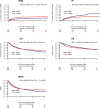Outcome of haploidentical versus matched sibling donors in hematopoietic stem cell transplantation for adult patients with acute lymphoblastic leukemia: a study from the Acute Leukemia Working Party of the European Society for Blood and Marrow Transplantation
- PMID: 33794963
- PMCID: PMC8017786
- DOI: 10.1186/s13045-021-01065-7
Outcome of haploidentical versus matched sibling donors in hematopoietic stem cell transplantation for adult patients with acute lymphoblastic leukemia: a study from the Acute Leukemia Working Party of the European Society for Blood and Marrow Transplantation
Abstract
Background: Non-T-cell depleted haploidentical hematopoietic stem cell transplantation (HaploSCT) is being increasingly used in acute lymphoblastic leukemia (ALL) with improving patient outcomes. We have recently reported that outcomes of adult patients (pts) with ALL in complete remission (CR) receiving HaploSCT are comparable to unrelated donor transplants. We now compared HaploSCT and matched sibling donor (MSD) transplants in pts with ALL.
Aim: To assess transplantation outcomes of HaploSCT and MSD transplants in pts with ALL in CR.
Methods: We retrospectively analyzed adult patients (≥ 18 years) with ALL who underwent their first allogeneic stem cell transplantation (alloSCT) in first or second CR between 2012 and 2018, either from a T cell replete Haplo or MSD donor, and whose data were reported to the Acute Leukemia Working Party (ALWP) of the European Society for Blood and Marrow Transplantation (EBMT). Multivariate analysis (MVA) adjusting for differences between the groups was performed using the Cox proportional hazards regression model. Propensity score matching was also performed to reduce confounding effects.
Results: The analysis comprised 2304 patients: HaploSCT-413; MSD-1891. Median follow-up was 25 months. Median age was 37 (range 18-75) and 38 (18-76) years in HaploSCT and MSD, respectively. HaploSCT patients were transplanted more recently than those transplanted from MSD (2016 vs 2015, p < 0.0001). A higher rate of HaploSCT was in CR2 (33.4% vs 16.7%, p < 0.0001), respectively, and fewer received myeloablative conditioning (68% vs 83.2%, p < 0.0001). Cytomegalovirus (CMV) seropositivity was lower in HaploSCT patients (22% vs 28%, p = 0.01) and donors (27.1% vs 33%, p < 0.02), and a higher proportion of the HaploSCTs were performed using a bone marrow (BM) graft (46.2% vs 18.6%, p < 0.0001). The 2 groups did not differ with regard to gender, Karnofsky performance status score, ALL phenotype, Philadelphia chromosome (Ph) positivity and pre-alloSCT measurable residual disease (MRD). Graft versus host disease (GVHD) prophylaxis was mainly post-transplant cyclophosphamide (PTCy) based (92.7%) in the HaploSCT setting, while it was mostly pharmacologic in the setting of MSD (18.7% received ATG). Cumulative incidence of engraftment at day 60 was higher in MSD transplants compared to HaploSCT (98.7% vs 96.3%, p = 0.001), respectively. Day 180 incidence of acute (a) GVHD II-IV and III-IV was higher in HaploSCT vs. MSD: 36.3% vs 28.9% (p = 0.002 and 15.2% vs 10.5% (p = 0.005), respectively. Conversely, the 2-year chronic (c) GVHD and extensive cGVHD were 32% vs 38.8% (p = 0.009) and 11.9% vs 19.5% (p = 0.001) in HaploSCT vs MSD, respectively. Main causes of death were leukemia (31.8% vs 45%), infection (33.1% vs 19.7%) and GVHD (16.6% vs 19.7%) for HaploSCT and MSD, respectively. Two-year relapse incidence (RI), non-relapse mortality (NRM), leukemia-free survival (LFS), overall survival (OS) and GVHD-free, relapse-free survival (GRFS) were 26% vs 31.6%, 22.9% vs 13%, 51% vs 55.4%, 58.8% vs 67.4% and 40.6% vs 39% for HaploSCT and MSD, respectively. In the MVA, RI was significantly lower in HaploSCT in comparison with MSD, hazard ratio (HR) = 0.66 (95% CI 0.52-0.83, p = 0.004), while NRM was significantly higher, HR = 1.9 (95% CI 1.43-2.53, p < 0.0001). aGVHD grade II-IV and grade III-IV were higher in HaploSCT than in MSD HR = 1.53 (95% CI 1.23-1.9, p = 0.0002) and HR = 1.54 (95% CI 1.1-2.15, p = 0.011), respectively. Extensive cGVHD was lower in HaploSCT compared with MSD, HR = 0.61 (95% CI 0.43-0.88, p = 0.007), while total cGVHD did not differ significantly, HR = 0.94 (95% CI 0.74-1.18, p = 0.58). LFS, OS and GRFS did not differ significantly between the 2 transplant groups, HR = 0.96 (95% CI 0.81-1.14, p = 0.66); HR = 1.18 (95% CI 0.96-1.43, p = 0.11) and HR = 0.93 (95% CI 0.79-1.09, p = 0.37), respectively. These results were confirmed in a matched-pair analysis.
Conclusions: Outcomes of adult patients with ALL in CR receiving alloSCT from haploidentical donors are not significantly different from those receiving transplants from MSD in terms of LFS, OS and GRFS.
Keywords: Acute lymphoblastic leukemia; Allogeneic stem cell transplantation; Donor; Haploidentical; Sibling.
Conflict of interest statement
The authors declare that they have none to report.
Figures

References
-
- Passweg JR, Baldomero H, Bader P, Bonini C, Duarte RF, Dufour C, et al. Use of haploidentical stem cell transplantation continues to increase: the 2015 European Society for Blood and Marrow Transplant activity survey report. Bone Marrow Transplant. 2017;52(6):811–817. doi: 10.1038/bmt.2017.34. - DOI - PMC - PubMed
-
- Di Stasi A, Milton DR, Poon LM, Hamdi A, Rondon G, Chen J, et al. Similar transplantation outcomes for acute myeloid leukemia and myelodysplastic syndrome patients with haploidentical versus 10/10 human leukocyte antigen-matched unrelated and related donors. Biol Blood Marrow Transplant. 2014;20(12):1975–1981. doi: 10.1016/j.bbmt.2014.08.013. - DOI - PMC - PubMed
Publication types
MeSH terms
LinkOut - more resources
Full Text Sources
Other Literature Sources

